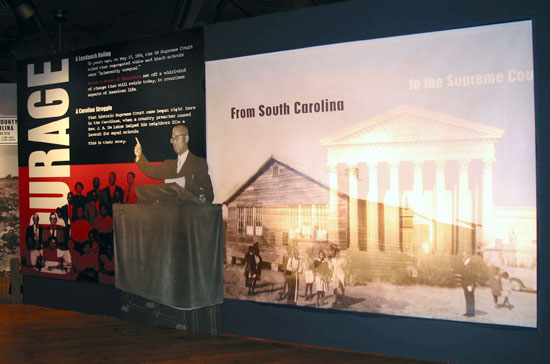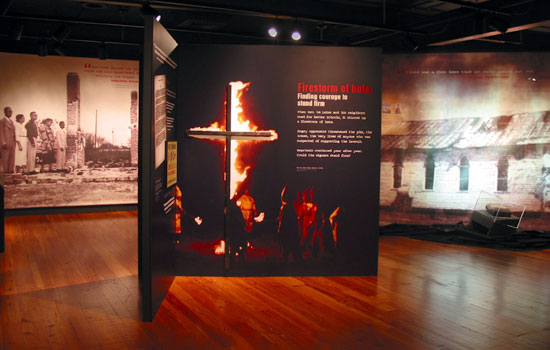COURAGE: The Carolina Story That Changed America
 LINK: Levine Museum of the New South
LINK: Levine Museum of the New South
Tom Hanchett’s, Museum Historian, remarks on accepting the AAM Exhibition Award in 2005: “Few Americans, even in the Carolinas, know the remarkable Civil Rights story of Rev. J.A. De Laine. An African American minister and school teacher in rural Clarendon County, South Carolina, he organized over 100 of his neighbors to file suit for equal schools. Celebrated attorney Thurgood Marshall argued the case all the way to the U.S. Supreme Court, where it was joined by four others under the title Brown v Board of Education.”
To tell the story, the we drew on photos and oral histories assembled by Rev. De Laine’s children Joe, Ophelia and BB, two of whom now reside quietly in Charlotte. Accomplished amateur historians, the De Laines became active partners in exhibit development. Leading the process was exhibition developer Darcie Fohrman, already a two-time winner of AAM’s Excellence in Exhibition award, notably for the children’s installation Daniel’s Story at the U.S. Holocaust Memorial Museum in Washington, DC. Fohrman’s skill at community collaboration carried the design process through numerous presentations to community members, teachers and middle-school students. The investment of time paid off in a tightly focused, emotionally powerful exhibition.
The 3500 square foot installation took visitors on a journey from rural South Carolina to the Supreme Court to issues today. Working with an extremely tight budget of under $100 per square foot, Fohrman and staff curator Dr. Tom Hanchett found creative ways to engage visitors. At the start, for example, the gallery entrance was mocked up as a “white school:” the door was locked and a sign directed visitors to a side entry. At the end, life-size cut-outs of current middle school students posed thought-provoking questions such as “Are schools now equal? Where is courage needed today?” and visitors responded with post-it notes. Throughout, photographs enlarged eight feet high by Kenny Color Lab of Charlotte provided the visual hallmark. Music, sounds, and a handful of hands-on pieces crafted by fabricator Studio Displays, such as a rough-hewn wooden school desk, engaged visitors’ senses. Five two-minute oral history videos of the De Laines, by Wonderworld Productions, gave first-person warmth.
The most innovative aspect of community programming was a civic-engagement effort called “Conversations on Courage.” Knight Foundation dollars supported a partnership with Charlotte’s Community Building Foundation, which brought local leaders to view and discuss the exhibition. The Museum bravely promised to involve 50 “intact management teams” – defined as executives who work together in a government, non-profit or corporate workplace – but over 110 ultimately participated. The opportunity to use history to dig into current issues of race and education attracted top decision-makers from the police department, courts, media, school system, banks, and more.





